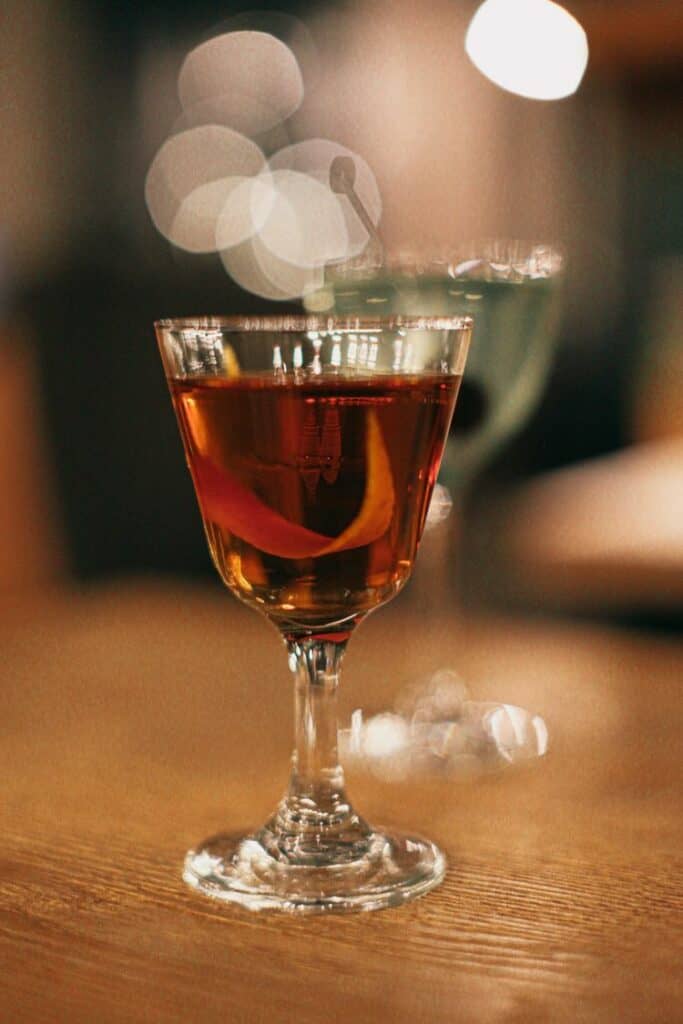Rye vs. Bourbon
Below are their most extensive comparisons, including their aging processes, distillations, and storage conditions.
Let’s start with their parallels:
- These are both whiskeys.
- Their constituents consist of mash made from grains such as Rye, corn, and barley.
- Both are distilled to a maximum of 160 proof (roughly 80 percent alcohol)
- Both are aged in the charred oak barrel at a maximum of 125 proof.
- Both are all-natural and additive-free.

Now for the fascinating part–Rye is created from 51 percent natural rye, whereas Bourbon is made from 51 percent maize. Bourbon has a sweeter, caramel-like flavor due to its maize basis, but Rye has a spicier flavor because of its rye grains.
Bourbon blossomed in Kentucky yet had French origins, whilst Rye originated in Pennsylvania.
Bourbon is matured in new 15-gallon barrels for a minimum of two years, while rye is aged for one year.
Rye is more often employed in cocktails since cocktails ask for more decadent flavors.
Rye is distilled in 26-gallon custom-built stills at a maximum of 160 proof, while Bourbon is produced in 50-100 gallon stills at a maximum of 160 proof.
Rye is stronger than Bourbon, which is softer.
Bourbon and Rye both have major origins and defining events in American history. According to historical records, the creation of Bourbon and Rye started in 1776, when the British war impeded the commerce of sugar required in the manufacturing of rum, putting a stop to rum production.
Meanwhile, Americans’ passion for spirits led to the distillation of local grains, rye, and maize, paving the route for the discovery of whiskey. Bourbon and Rye are entrenched in every American whiskey drinker, despite having distinct histories in the United States.
Bourbon and Rye: Their Place of Origin
If you are a native American, Kentucky comes to mind when you think about Bourbon. How did the state of Kentucky become linked with Bourbon? It is because Kentucky produces 95 percent of the world’s Bourbon. According to local folklore, the enormous quantities of limestone in Kentucky’s tap water filters provide a superior flavor to the rest of the nation’s tap water. Therefore, it is ideal for whiskey distillation.
The fact that Kentucky’s soil is ideal for producing maize, the primary component in Bourbon, is another reason why the state is ideal for bourbon manufacturing. Therefore, Bluegrass State is the symbol of Bourbon. Why, then, is it named Bourbon and not Kentucky? Some claim that it was named after the French Bourbon monarchy in acknowledgment of France’s help during the American Revolution; however, this is not definitively documented.
Farmers from eastern Europe moved to Pennsylvania in the 17th century, carrying rye seeds with them. They sowed these seeds in Pennsylvania’s rugged terrain and then distilled the grains into whiskey. Due to its maize and barley harvests, which are both components of rye, Maryland became a rye grower as well. Pennsylvania and Maryland became the leading producers of rye whiskey, and the rest is history.
Identity Crisis in the World of Bourbon
A variety of elements influences bourbon’s taste, but the three most essential components are 51 percent maize, barley, and a third grain that changes from brand to brand. However, some Bourbons broke with tradition and developed their own character. There are recipes for Bourbon that comprise 70% maize and about equal percentages of barley and Rye. Then there is the spicy “high-rye” version, which clearly has a greater proportion of Rye. Additionally, there is the “traditional wheat recipe,” which has a softer and sweeter consistency.
Is Rye Whiskey the Same Thing as Bourbon?
To qualify as rye whiskey, a Bourbon must contain at least 51 percent rye grain. This is the standard legal distinction between rye whiskey and Bourbon in various nations. Therefore, despite their similarity in distillation and ingredients, Bourbon cannot be considered rye whiskey unless it contains at least 51 percent rye grain.
Can I Use Rye in Place of Bourbon?
Rye has several unique flavors, but its peppery tint and malt bill sting are the most prominent. Some rye may have a robust flavor, leaving the throat with scorching heat. Some begin rougher but become smooth and thin with swallowing. Some begin smoothly, but the burn eventually intensifies. Nevertheless, regardless of the flavor that appeals to your palette, you can certainly taste the rye difference.
The honeyed sweetness of bourbon is its trademark flavor. Grain, caramel, cinnamon, and nutmeg are the four prominent taste categories in bourbon. That’s where the sweetness of Bourbon comes from. The flexibility of bourbon makes it the top option among bartenders and consumers, making it the star of the cocktail world. Bourbon may be found in several cocktail recipes.
The Final Conclusion
That’s it, whiskey aficionados! The decision between Rye and Bourbon might be difficult. However, regardless of your opinion, both alcoholic beverages are delicious in their own way.
While rye whiskey is considered America’s actual native spirit, Bourbon has the distinction of being a uniquely American product.
Go to the bars in West Village or local liquor shop, select a bottle, and examine and sample the delicious contents. There is nothing better than a nice experience with fine whiskey.